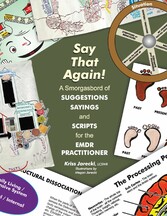Say That Again! - A Smorgasbord of Suggestions, Sayings and Scripts for the EMDR Practitioner
von: Kriss Jarecki LCSWR
BookBaby, 2022
ISBN: 9781667851860
, 144 Seiten
Format: ePUB
Kopierschutz: frei
Preis: 7,13 EUR
eBook anfordern 
Mehr zum Inhalt

Say That Again! - A Smorgasbord of Suggestions, Sayings and Scripts for the EMDR Practitioner
Though this book is written with the EMDR practitioner in mind, it has several chapters of suggestions, scripts and ways to word discussions that can assist any practitioner. This book is a 'how to' that's packed with trauma-informed/trauma-sensitive discussions with clients and explanations and scripts for interventions spanning from 'hello' to 'congratulations, you completed therapy!' Learn four ways such as the 'sandwich analogy' to explain how we digest experiences (Adaptive Information Processing- AIP), how 'indigestion' happens and how to explain EMDR. Brain chemistry, Polyvagal Theory and Memory reconsolidation will be explained. Use the 'Journey Questionnaire' for adults and the 'Tree of Me' for kids to gather a client's good and not-so-good experiences and 'As the Wheel Turns' to present a case formulation. Examine illustrations and scripts for interventions such as the 'Computer/TV Tool' and 'Positive Parts on the Team' used as resources to help clients effectively manage feelings and situations. We will also take a look at the spectrum of dissociation and unpack challenges around understanding and utilizing the EMDR script, dual attention stimulus methods, number of passes, when to use cognitive interweaves, understanding and working with ecological 1 and 6, etc. Other scripts include explaining the EMDR Procedure, utilizing floatback, a lengthy list of cognitive interweaves, working with clusters and preparing for future situations. The book also includes a special section on using the Seed to Weed Technique as an illustrated metaphor to explain trauma, monitor progress and show treatment outcomes. Look inside for much more!










